14. Brushes

Brush settings apply to many Photoshop tools, such as the Brush, Pencil, Mixer Brush, Clone Stamp, History Brush, Sharpen, Dodge, Burn, and Eraser.
In this chapter, you will paint with the Brush tool, choose basic brush settings, choose and customize brushes using a wide assortment of controls, and manage brush presets. You will also create bristle brushes for the Mixer Brush tool and use it to transform a photo into a painting, and use the History Brush tool to restore areas of an image.
Note: Although we recommend using a stylus and tablet for the instructions in this chapter, it’s not a requirement.
Using the Brush tool
Before delving into the complexities of the Brush panel, take a few minutes to familiarize yourself with the Brush tool. To do this, you will choose a brush preset for the tool and choose Options bar settings to control its behavior.
To use the Brush tool
1. Click an image layer or create a new, blank layer. Optional: To confine your brush strokes to a specific area of the layer, create a selection.
2. Choose the Brush tool ![]() (B or Shift-B).
(B or Shift-B).
3. Choose a Foreground color.
4. On the Options bar, do the following:
Click the Brush Preset picker arrowhead or thumbnail,A then click a preset.

A Click the Brush Preset picker arrowhead or thumbnail on the Options bar, then double-click a preset on the picker. (Via the picker menu, we set our panel view to Stroke Thumbnail.)
Choose a blending Mode.
Choose an Opacity percentage. At 100%, the stroke will completely cover underlying pixels.
Choose a Flow percentage for the rate at which “pigment” is applied (for thick or thin coverage).
5. Optional: If you’re using a stylus and tablet, you can activate the Pressure for Opacity button ![]() and/or the Pressure for Size button
and/or the Pressure for Size button ![]() on the Options bar.
on the Options bar.
6. Draw strokes in the image. Feel free to change Options bar settings between strokes.
• On the Layers panel, click the Lock Transparent Pixels button ![]() for the current layer to allow the tool to edit only nontransparent pixels.
for the current layer to allow the tool to edit only nontransparent pixels.
• To draw a straight stroke with a painting tool (e.g., the Brush tool), hold down Shift while dragging.
• To sample a color with a temporary Eyedropper, Alt-click/Option-click in the document.
Choosing temporary brush settings
There are a gazillion ways to customize a brush preset; we’ll begin with size, hardness, and opacity. The settings will remain in effect until you choose a different preset.
To change the size or hardness of a brush via a slider
1. Choose a tool that uses brush presets, such as the Brush, Pencil, or Mixer Brush, and click a preset on the Brush Preset picker or Brush Presets panel.
2. Do either of the following:
Open the Brush Preset picker via the Options bar or by right-clicking in the image, then change the Size and, if available, the Hardness value (you can use the scrubby sliders), then press Enter/Return.
On the Brush panel ![]() or the Brush Presets panel,
or the Brush Presets panel, ![]() adjust the Size value.
adjust the Size value.
To change the brush size interactively
1. Follow step 1, above.
2. Press [ or ] or hold down Alt-right-click/Control-Option and drag horizontally in the image.
• To have Photoshop display a readout of the current Size, Hardness, and Opacity values as you adjust a brush interactively, go to Preferences > Interface, then choose a location option on the Show Transformation Values menu. ![]()
To change the brush hardness or opacity interactively 
1. In Preferences > General, check Vary Round Brush Hardness Based on HUD Vertical Movement to set the shortcut to change the tool hardness, or uncheck this option to have it change the tool opacity. Also, to display the hardness or opacity value within the cursor as a tint, show the Performance panel and make sure Use Graphics Processor is checked (if it’s not, check it, click OK, then relaunch Photoshop).
2. Choose the Brush tool, ![]() then hold down Alt-right-click/Control-Option and drag vertically in the image.A You can also use this method to change the hardness or opacity for the Pencil, Color Replacement, Clone and Pattern Stamp, History and Art History Brush, Background Eraser, Blur, Sharpen, Smudge, Dodge, and Burn tools. For the Eraser tool, you can change only the hardness.
then hold down Alt-right-click/Control-Option and drag vertically in the image.A You can also use this method to change the hardness or opacity for the Pencil, Color Replacement, Clone and Pattern Stamp, History and Art History Brush, Background Eraser, Blur, Sharpen, Smudge, Dodge, and Burn tools. For the Eraser tool, you can change only the hardness.

A With Alt-right-click/Control-Option held down, we’re dragging vertically in the image to change the brush hardness.
Customizing a brush
Via a wide array of features on the Brush panel, you can customize the characteristics of any brush for use with the Brush, Mixer Brush, Eraser, or History Brush tool (all of which are featured in this chapter), and for the Pencil, Clone Stamp, Pattern Stamp, Art History Brush, Blur, Sharpen, Smudge, Dodge, or Burn tool.
On the Brush panel, most of the settings for customizing brushes are organized into option sets; a few lone options simply are switched on or off. Many of the options add randomness or variation to a stroke, such as to its shape, texture, or color.
The availability of options varies depending on the currently chosen tool and tip, and some options apply only to a graphics tablet and stylus (when an option set is unavailable, the set name is dimmed). The choices are vast, so we’ll just focus on a few of our favorites here. With practice, you’ll learn which options and settings suit your painting style.
To customize a brush via the Brush panel
1. Choose one of the tools that we listed at the top of this page. To see the greatest differences among the settings, choose the Brush tool ![]() or Mixer Brush tool
or Mixer Brush tool ![]() (B or Shift-B).
(B or Shift-B).
2. To show the Brush panel, click the panel tab or icon, ![]() or click the Toggle Brush Panel button
or click the Toggle Brush Panel button ![]() on the Options bar or Brush Presets panel. Click Brush Tip Shape in the top left corner of the panel, and for this task, click a round or static tip (a tip that doesn’t look like a brush, pencil, or airbrush).A
on the Options bar or Brush Presets panel. Click Brush Tip Shape in the top left corner of the panel, and for this task, click a round or static tip (a tip that doesn’t look like a brush, pencil, or airbrush).A

A Via the Brush panel, you can select a brush tip, customize it via an assortment of options, and save it as a preset. The preview at the bottom of the Brush panel updates dynamically as you change the settings.
3. As you adjust settings for the tip, also keep an eye on the stroke preview at the bottom of the panel:
To change the brush Size (diameter), use the slider or scrubby slider. For a static tip, the brush Size can be increased up to 5000 px. ![]()
• To restore the original size to a static tip, click the Restore Original Size button. ![]()
To change the Angle (slant) of an elliptical tip, use the scrubby slider, or drag the arrowhead around the circle, or enter a specific angle.
To change the Roundness of the tip (make it more oval or more circular),B use the scrubby slider or drag either of the two small dark circles on the ellipse inward or outward.

To change the Hardness of the tip (feather or sharpen its edge),C use the scrubby slider.

To control the distance between marks within the stroke, check Spacing, then move the slider A–B or turn this option off to let the speed of your brush stroke control the spacing.
A With the Spacing option checked, the spacing is uniform: 25% Spacing (top) and 150% Spacing (bottom).
B With the Spacing option unchecked, the spacing is uneven: A slow stroke (top) and a fast stroke (bottom).
4. Next, you’ll customize the behavior variations for the brush using five of the option sets on the panel. Checking the box for an option set activates the current settings for that set; clicking the set name both activates the current settings and displays the set options.
To control the amount of allowable variation in the brush tip shape, click Shape Dynamics, then do any of the following:
Choose Size Jitter,C Angle Jitter, and Roundness Jitter values to establish an allowable amount of random variation for those attributes. The variations are more noticeable when the Spacing value (in the Brush Tip Shape option set) is greater than 10%.
100% Size Jitter, 25% spacing

C 0% Size Jitter
Check Brush Projection to enable round and static tips to respond to stylus movement, or to Tilt and Rotation settings in the Brush Pose option set. ![]()
If you’re using a stylus, from each of the Control menus, choose which stylus feature is to control the variation for that option. Note that variations will occur even when this setting is Off.
Choose Minimum Diameter and Minimum Roundness percentages.
5. To control the placement of pigment in the stroke, click Scattering, then do any of the following:
Check Both Axes to scatter pigment along and perpendicular to the stroke you draw, or uncheck this option to scatter pigment only perpendicular to the stroke.D Choose a Control option, if desired.
0% Scatter, 100% Spacing
500% Scatter, the Both Axes option checked
D 500% Scatter, the Both Axes option unchecked
Choose a Scatter percentage to control how far the pigment can stray from the stroke. The lower the Scatter percentage, the more solid the stroke.
Choose a Count value to control the number of marks in the stroke (you may need to increase the Spacing value to see any effect).
Choose a Count Jitter percentage to control the amount of variation in the Count.E

0% Count Jitter, 100% Spacing

E 100% Count Jitter: The Count varies randomly from 1% to 100% of the Count value.
6. Use settings in the Color Dynamics option set to control the amount of hue, saturation, and brightness variation. Check Apply per Tip ![]() to allow jitter settings to display randomly in each tip mark in a stroke, for a multicolor effect.
to allow jitter settings to display randomly in each tip mark in a stroke, for a multicolor effect.
7. To display a subtle texture in the stroke, click Texture, then do all of the following:
Click the Pattern picker thumbnail, then click a pattern swatch.
Choose a Scale value for the pattern.
Choose values for Brightness and Contrast. ![]() For a more prominent texture, choose a low Brightness value and a high Contrast value.
For a more prominent texture, choose a low Brightness value and a high Contrast value.
Choose a Depth value to simulate the depth of a fibrous drawing surface. High values produce more ridges and therefore a more noticeable texture.A

A Canvas pattern, 200% Scale, –90 Brightness, 80 Contrast
8. To control how randomly the overall stroke opacity can vary as you use the tool, and to make the Texture option more pronounced,B click Transfer, then do any of the following:
B The same Texture settings as above with Transfer: 60% Opacity Jitter, 60% Flow Jitter
Choose an Opacity Jitter percentage for the amount the opacity can vary.C–D Choose a Control option to control the fading.

C 10% Opacity Jitter, 10% Flow Jitter
D 80% Opacity Jitter, 80% Flow Jitter
Choose a Flow Jitter percentage to control the rate at which paint is applied. A high Flow Jitter will make the stroke dry and blotchy, but that may be the look you’re after. Choose a Control option.
9. Beware! The custom settings that you have chosen are only temporary. To save them as a preset for future use, click the Create New Brush button ![]() at the bottom of the Brush panel. Enter a descriptive name in the Brush Name dialog, check Capture Brush Size in Preset (if desired), then click OK. Your saved preset will appear at the bottom of the Brush Presets panel and in the Brush Preset picker.
at the bottom of the Brush panel. Enter a descriptive name in the Brush Name dialog, check Capture Brush Size in Preset (if desired), then click OK. Your saved preset will appear at the bottom of the Brush Presets panel and in the Brush Preset picker.
10. You’re ready to paint with your customized brush!
• Click the open ![]() or closed
or closed ![]() lock icon for an option set to prevent or allow the settings in that set from being edited, regardless of the current preset.
lock icon for an option set to prevent or allow the settings in that set from being edited, regardless of the current preset.
An Erodible Point tip behaves like a soft pencil: The beginning of the stroke is sharp and then it gradually wears down (widening and becoming more blunt) toward the end of the stroke.
To use an Erodible Point tip 
1. Choose the Brush tool ![]() or Mixer Brush tool.
or Mixer Brush tool. ![]()
2. On the left side of the Brush panel, click Brush Tip Shape, then click an Erodible Point tip in the scrolling window (look for the blunt-tipped pencil icons).
3. Activate the Live Tip Brush Preview button ![]() (see the sidebar at right).
(see the sidebar at right).
4. Choose a Size value to set the width of the end of the stroke (where the tip is worn down), and choose a Softness value to control how quickly the tip erodes. Lower values keep the tip more sharp.A
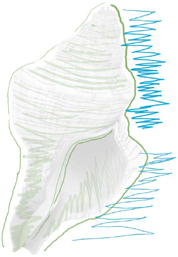
A We used the Pencil brush preset (an Erodible Point tip) to create the blue lines in this drawing. A high Softness value was used for the upper stroke; a very low Softness value was used for the lower one.
5. On the Shape menu, choose a preset shape.
6. Optional: To display some texture in the stroke, click the Texture option set and choose a burlap or canvas texture in the Pattern picker.
• To mimic a tilted pencil or pastel stick when drawing with a mouse, increase the Tilt Y value in the Brush Pose option set.
• Once you start painting with an Erodible tip (Shape: Point or Round; increased Softness setting), you can resharpen the tip by clicking Sharpen Tip.
• To produce long strokes when using an Erodible Point tip with the Mixer Brush tool, choose the Dry, Heavy Load preset from the Useful Mixer Brush Combinations menu on the Options bar.B

B We drew the green lines with the Charcoal Pencil brush preset and the brown strokes with the Triangle Pastel brush preset.
The Airbrush tips simulate the look of paint that is sprayed from an airbrush device. Via panel options, you can control the degree of graininess and feathering.
To use an Airbrush tip 
1. Choose the Brush tool ![]() or Mixer Brush tool.
or Mixer Brush tool. ![]()
2. On the left side of the Brush panel, click B rush Tip Shape, then click one of the Airbrush tips in the scrolling window (look for the airbrush icons).
3. Activate the Live Tip Brush Preview button. ![]()
4. Change any of the following settings:
Choose a Size value to set the size of the stroke.
Choose a Hardness value to control the amount of feathering at the edges of the stroke.
Increase the Granularity value to make the stroke look more speckly, and set a Spatter Size and Spatter Amount to control the size and number of droplets in the stroke.C

C We used the Watercolor Spatter Big Drops preset (which has a high Granularity value) to draw the dotted stroke on the left, the Airbrush Soft High Density Grainy preset to draw the blue line in the center, and the Watercolor Wash brush preset to draw the wide blue stroke on the right.
• All of the presets used here are in the default library. To identify them by name, choose either of the List views on the Brush Presets panel.
• If you’re going to paint with a mouse, display the Brush Pose option set. To spray a conical stroke from the point where you click, change one or both Tilt values; for a wider stroke, lower the Pressure value. To further elongate a conical shape, in the Brush Tip Shape option set, choose a high Distortion value. (See also the sidebar on page 278.)
• When using an airbrush tip with the Mixer Brush tool, choose the Dry, Heavy Load preset (Useful ... Combinations menu) to produce long strokes.
Managing brush presets
The Brush Presets panel stores and displays presets, like the Brush Preset picker, plus it offers several additional features. You can use this panel to save and choose brush presets, resize the current preset, save and load brush preset libraries, and access the Preset Manager.A Unlike the Brush Preset picker, the Brush Presets panel can be left open.

A Use the Brush Presets panel to select a preset from the current library, change the brush size, load a different library, create a new library, or access the Preset Manager dialog.
To use the Brush Presets panel
1. Choose a tool that uses brushes, such as the Brush, Mixer Brush, or Pencil.
2. To show the Brush Presets panel, click the panel tab or icon ![]() (Window > Brush Presets), or click Brush Presets in the upper-left corner of the Brush panel.
(Window > Brush Presets), or click Brush Presets in the upper-left corner of the Brush panel.
3. On the panel, do any of the following:
Click a preset brush to be used with the current tool.
Change the brush Size (diameter). Note: You can restore the original size of some kinds of brush tips by clicking the Restore Original Size button. ![]()
To load different presets onto the panel, choose a library name from the panel menu, then click Append or OK (see also page 117). (Via the panel menu, you can also choose a different thumbnail or list option for the panel.)
To save the current brush and its settings as a preset, click the Create New Brush button, ![]() add to or change the name in the Brush Name dialog (be descriptive), then click OK.
add to or change the name in the Brush Name dialog (be descriptive), then click OK.
To save all the presets that are currently on the panel as a new library, choose Save Brushes from the panel menu, type a name for the library, then click Save (see also page 117 or page 119).
To access the Preset Manager dialog, from which you can append, replace, and reset which items load onto the Brush and Brush Presets panels and the Brush Preset picker at startup, click the Open Preset Manager button, ![]() then see “Using the Preset Manager” on page 119. (This button is also available on the Brush panel.)
then see “Using the Preset Manager” on page 119. (This button is also available on the Brush panel.)
To delete the currently selected preset from the panel (but not from its library), click the Delete Brush button, then click OK. ![]()
Activate the Live Tip Brush Preview button, ![]() (if available), to display a schematic of the tip.
(if available), to display a schematic of the tip.
Using the Mixer Brush tool
By choosing brush characteristics for the Mixer Brush tool, you can mimic different types of natural bristle brushes, such as oil paint or gouache. You can also control the wetness of the paint, the paint flow, and the degree to which existing colors mix with new strokes. Photoshop “paint” lacks the viscosity of traditional oils, but you can achieve some nice effects with it nevertheless.
To build a bristle brush
1. Choose the Mixer Brush tool ![]() (B or Shift-B).
(B or Shift-B).
2. Display the Brush panel. ![]() If the bristle tips (which look like a drawing of a brush) aren’t showing on the panel, as in figure A, click Brush Presets. From the Brush Presets panel menu, choose Reset Brushes. Click OK in the alert dialog, then click the Toggle Brush Panel button
If the bristle tips (which look like a drawing of a brush) aren’t showing on the panel, as in figure A, click Brush Presets. From the Brush Presets panel menu, choose Reset Brushes. Click OK in the alert dialog, then click the Toggle Brush Panel button ![]() to return to the Brush panel.
to return to the Brush panel.
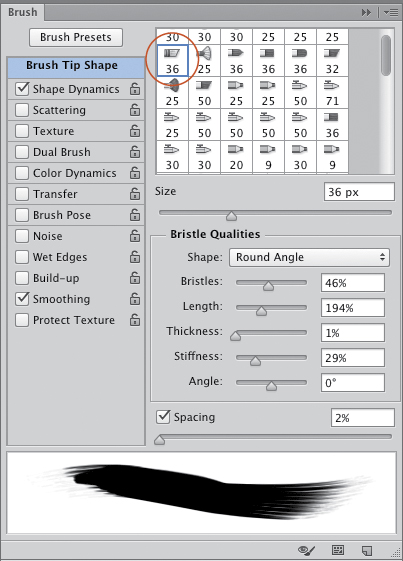
A When the Mixer Brush tool and a bristle tip are selected, Bristle Qualities options display on the Brush panel.
3. Click Brush Tip Shape, then click a bristle tip in the scrolling window. The shape name is listed on the Shape menu.
4. Activate the Live Tip Brush Preview button. ![]()
5. To pare down the number of options that will affect your brush, either uncheck all the options on the left side of the panel except Smoothing or choose Clear Brush Controls from the panel menu.
6. Use the Bristle Qualities sliders to choose these physical characteristics for the tip, while noting the changes in the preview:
Bristles controls the number (density) of bristles.
Length controls the length of the bristles.
Thickness controls the width of the bristles (and therefore affects the overall density of the stroke).
Stiffness controls how easily the bristles bend. Choose a low value for smooth, fluid strokes or a high value for scratchy, dry bristle marks.
Angle controls the brush angle if you’re using a mouse. Angle variations are most noticeable when one of the “Flat” shapes is chosen for the tip.
7. Choose Options bar settings for the Mixer Brush tool by following the steps on the next page.
• You can record the creation of a painting or drawing via an action, and then replay the process again at any time. The artwork will reappear onscreen, stroke by stroke. See Chapter 22.
Before using the bristle brush that you have just chosen qualities for, you also need to choose settings to control how the brush will apply pigment.
To choose paint options for a bristle brush
1. After following the instructions on the preceding page, and with the Mixer Brush tool still selected, on the Options bar, do both of the following:
Activate the Load Brush After Each Stroke button ![]() to have the current Foreground color reload onto the brush after each stroke (the Mix value must be below 100% for this option to work).
to have the current Foreground color reload onto the brush after each stroke (the Mix value must be below 100% for this option to work).
Activate the Clean Brush After Each Use button ![]() to have a clean Foreground color reload after each stroke, or deactivate this option to allow the last colors in the brush to mix with the current Foreground color.
to have a clean Foreground color reload after each stroke, or deactivate this option to allow the last colors in the brush to mix with the current Foreground color.
2. From the Useful Mixer Brush Combinations menu, choose a preset combination of settings. The Dry presets are good for defining object details and edges, the Moist presets allow for moderate paint mixing, and the Wet and Very Wet presets work well for blending new strokes with existing ones.
If you prefer to choose custom options (or to refine the settings from a preset), do any of the following:
Choose a Wet value to control the dryness (or gloppiness) of the existing paint and the extent to which your brush can pick it up in the stroke.A–B
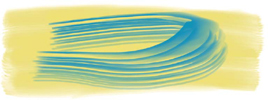
A Options bar settings of Wet 10 and Mix 10: The stroke barely blended with the existing color.
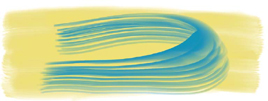
B Wet 90 and Mix 10: The stroke blended somewhat with the existing color.
Choose a Load value to control how much paint is supplied to the brush (how quickly the brush runs out of paint), most noticeable with a low Mix value.
Choose a Mix value to control the degree to which existing strokes (including any white from the Background) mix or smear with new strokes.C–D

C Wet 10 and Mix 90: The stroke blended and smeared more with the existing color.

D Wet 90 and Mix 90: The stroke blended and smeared almost entirely with the existing color.
Choose a Flow value to control the rate at which paint is applied (the amount of coverage).
Check Sample All Layers to allow the brush to mix with and pick up paint from all layers.
3. Time to paint! Create a new, blank layer (it can be above an image layer), then stroke, stroke, stroke.
Use this method if you want to wipe a brush clean manually before applying more color — that is, override an activated Load Brush After Each Stroke ![]() or Clean Brush After Each Stroke
or Clean Brush After Each Stroke ![]() button.
button.
To wipe a bristle brush clean
With the Mixer Brush tool selected, click the Current Brush Load menu ![]() on the Options bar, click Clean Brush, then click Load Brush.
on the Options bar, click Clean Brush, then click Load Brush.
In this exercise, you will reinterpret shapes in a photo with the Mixer Brush tool, to produce a digital painting.
To turn a photo into a painting
1. Open a photo A and duplicate the Background.
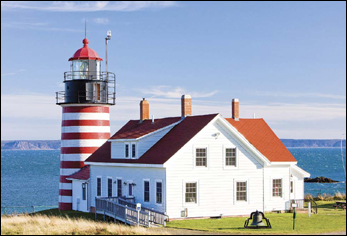
A This is the original photo — a quintessential New England landscape.
2. Hide the duplicate layer, click in the original Background, then use Edit > Fill to fill it with White. To add a texture, use Edit > Fill again, except this time choose Use: Pattern, choose the Canvas pattern (Artist Surfaces library) from the Pattern picker menu, set the Opacity to 75%, and click OK.
3. Click the Background copy, and make it visible again. Create several blank layers, and keep one of them selected.B

B This is how the Layers panel looked by the end of step 3 on this page.
4. Choose the Mixer Brush tool ![]() (B or Shift-B).
(B or Shift-B).
5. On the Brush Presets panel, ![]() click a preset, such as a flat, blunt preset to fill in broad areas or a point preset to draw fine lines.
click a preset, such as a flat, blunt preset to fill in broad areas or a point preset to draw fine lines. ![]()
6. On the Options bar, do all of the following:
From the Useful Mixer Brush Combinations menu, choose a preset to control the character of the paint. The Wet and Very Wet presets are good for painting broad areas, such as backgrounds, and for picking up colors from a photo; the Moist and Dry presets are better for defining details.
Check Sample All Layers to allow the brush to pick up and mix colors from all the underlying layers (strokes will appear only on the selected layer).
If you’re using a stylus and tablet, activate the Pressure Controls Size button. ![]()
7. To transform your photo into a painting, do either of the following:
To reinterpret the photo with a “clean” brush, deactivate the Load Brush After Each Stroke button ![]() on the Options bar and activate the Clean Brush After Each Stroke button
on the Options bar and activate the Clean Brush After Each Stroke button ![]() (now the current Load button setting will have no effect). Start each new brush stroke over the desired color (because “Clean Brush After Each Stroke” is activated) (A, next page).
(now the current Load button setting will have no effect). Start each new brush stroke over the desired color (because “Clean Brush After Each Stroke” is activated) (A, next page).

A We deactivated the Load Brush After Each Stroke option so we could pick up colors from the photo layer, chose “Wet, Heavy Mix” from the Useful MIxer Brush Combinations menu, then applied brush strokes on a few blank layers.
To sample a color from the photo, activate the Load Brush After Each Stroke button on the Options bar, then Alt-click/Option-click in the photo. Lower the opacity of the photo layer, click a paint layer, then paint with the sampled color (B–C, next page and A–B, page 282).
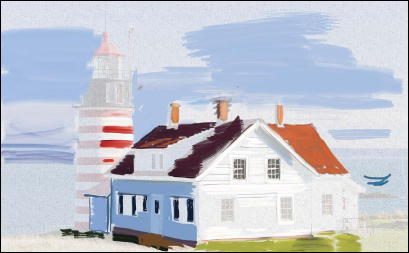
B We activated Load Brush After Each Stroke, sampled a color in the photo, lowered the opacity of the photo layer, clicked another blank layer, then painted with a couple of the Moist preset combinations and a couple of the Wet ones.
• When sampling a color, make sure the photo layer is at 90% to 100% Opacity. You can lower the opacity of the photo layer before painting.

C Next, we painted the sky with the Round Fan Stiff Thin Bristles and Flat Point Medium Stiff presets, painted the water with the Round Blunt Medium Stiff and Round Point Stiff presets, and painted the siding on the building with the Round Point Stiff preset and the Dry, Heavy Load combination.
• All the presets mentioned above are in the default brush library. To view the preset names, choose Small or Large List from the Brush Presets panel menu.

A Finally, on the topmost layer, Peter painted with the Round Point Stiff preset and used the Dry combination to prevent the final line work from blending with the other paint layers. Now the image looks like an artist’s painting. Note that he didn’t slavishly replicate every tiny detail in the photo — that’s what artistic license is all about!

B Peter transformed this photo in a similar way to the one shown above, using the Mixer Brush tool, a bristle tip, and a few different Useful Combination presets.
• Paint the picture in sections, each one on one of the blank layers you created. To erase any unwanted strokes, use the Eraser tool (see page 282).
• As you apply brush strokes, mimic the direction of the original shapes in the photo. To add variety to your strokes, switch bristle tips.
Using the Eraser tool
The Eraser tool removes image pixels permanently, so it should be used only to delete areas from a duplicate layer or from a layer that contains just retouching or painting edits that were made via the Sample All Layers option. Don’t use it on the original Background!
To use the Eraser tool
1. Choose the Eraser tool ![]() (E or Shift-E).
(E or Shift-E).
2. On the Options bar, do the following:
Click a Soft Round brush on the Brush Preset picker.
Choose a Mode (shape) of Brush, Pencil, or Block.
For Brush or Pencil mode, choose an Opacity percentage; for Brush mode, deactivate the Airbrush button and keep the Flow setting at 100%.
3. Click a layer, make sure the Lock Transparent Pixels button ![]() is deactivated, then drag to erase pixels. To adjust the brush diameter, press [ or ].
is deactivated, then drag to erase pixels. To adjust the brush diameter, press [ or ].
• Instead of erasing image pixels permanently, hide them via an editable layer mask (see pages 172–173).
Using the History Brush tool
When you apply strokes to a document with the History Brush tool, pixels below the pointer are restored from whichever state or snapshot you have designated as the history source.
Note: Photoshop prevents the use of the History Brush tool if you apply specific kinds of edits after opening your document, such as changing the document color mode or canvas size or cropping. Also, the tool can’t be used to recover pixels from a layer that you have deleted, and it works only on 8-bit images.
To use the History Brush tool
1. Click an image layer (or duplicate the Background), and apply some edits, such as a filter or brush strokes (but none of the edits listed in the Note above).A–C
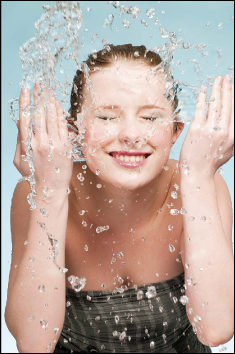
A This is the original image.
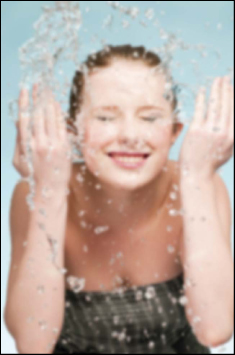
B We duplicated the image layer via Ctrl-J/Cmd-J, then applied the Gaussian Blur filter to the duplicate.

C We used a Hue/Saturation adjustment layer (Colorize option) to apply a blue-green tint, then merged that layer into the duplicate image layer.
2. Choose the History Brush tool ![]() (Y or Shift-Y).
(Y or Shift-Y).
3. On the Options bar:
Click the Brush Preset picker arrowhead, then click a brush on the picker.
Choose a blending Mode, Opacity percentage, and Flow percentage.
4. On the Layers panel, click the layer you edited, and make sure the Lock Transparent Pixels button ![]() is deactivated.
is deactivated.
5. On the History panel, click in the leftmost column for a state, to designate it as the source for the History Brush tool. The history source icon ![]() appears in that slot.A Note: If you added a layer during the course of editing (step 1), set the history source to the New Layer or Layer Via Copy state.
appears in that slot.A Note: If you added a layer during the course of editing (step 1), set the history source to the New Layer or Layer Via Copy state.

A To set the history source icon, we clicked in the leftmost column for the state in which we duplicated the image layer.
6. Apply strokes to the image. Pixel data from the source state will replace the current data where you apply strokes.B–C

B We set the opacity for the History Brush to 70% and chose the Round Blunt Medium Stiff bristle preset. We applied strokes to selectively restore the original, unedited image in scratchy strokes.
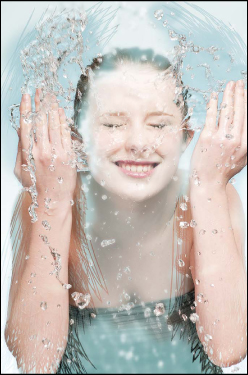
C Finally, with a Soft Round tip and the History Brush Opacity set to 50%, we partially restored some areas of the model’s face and neck from the original Background image.
• We recommend using the History Brush immediately after applying edits that you want to remove selectively. This way, it will be easier for you to identify which state you want to use as a source.
• If you add a layer to your document that you want to remove edits from via the History Brush tool, set the source icon to the New Layer state.


